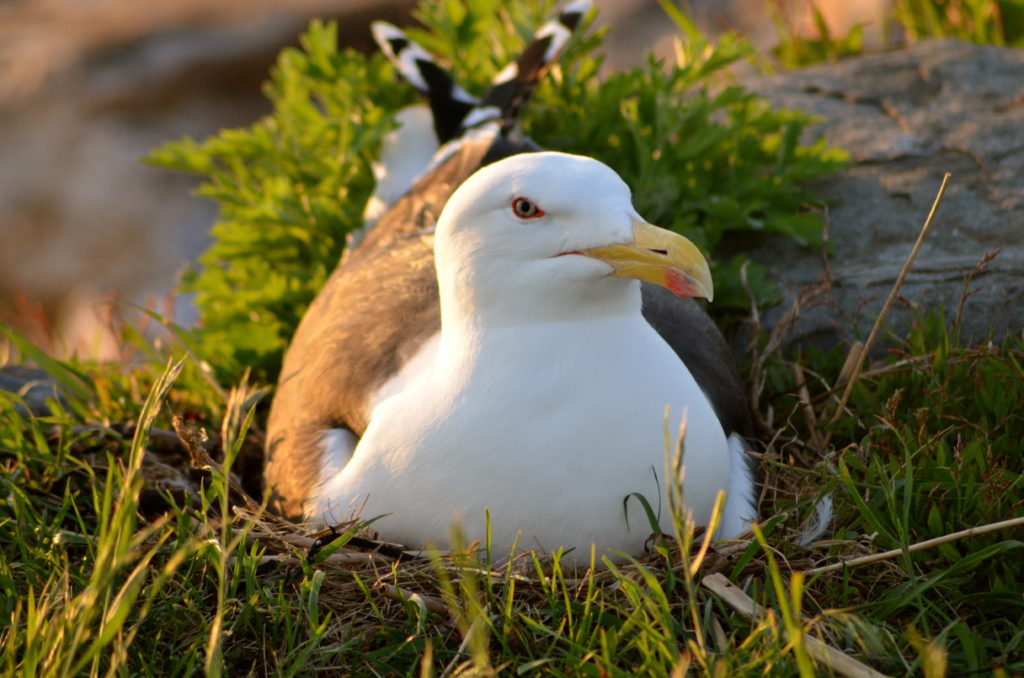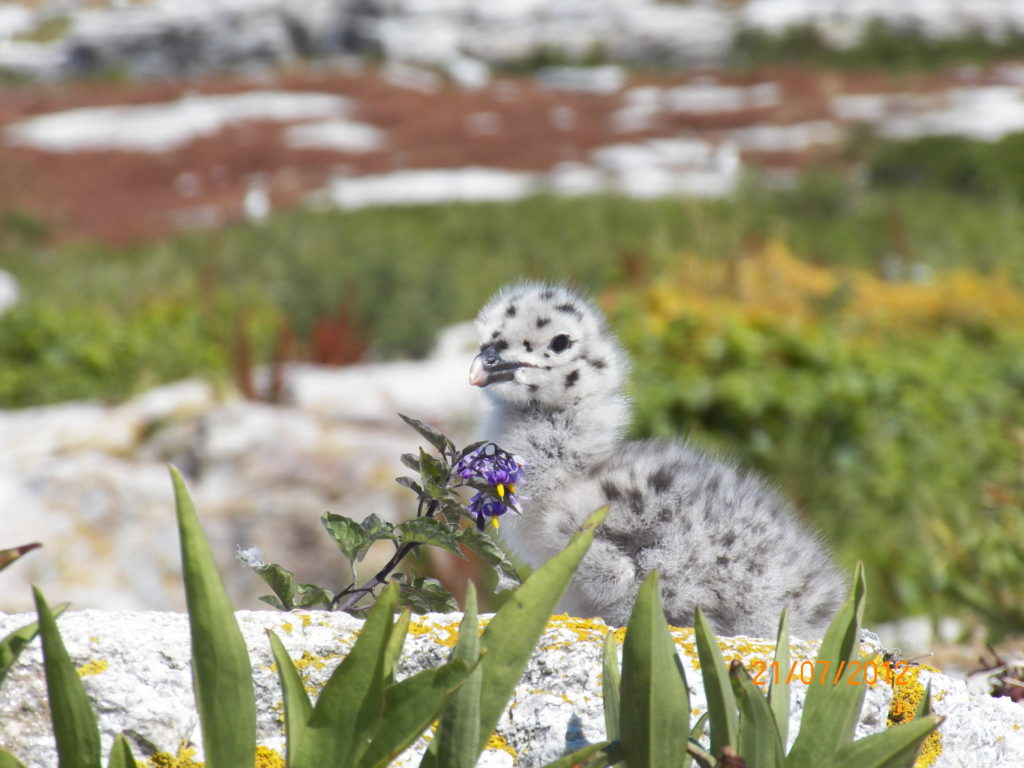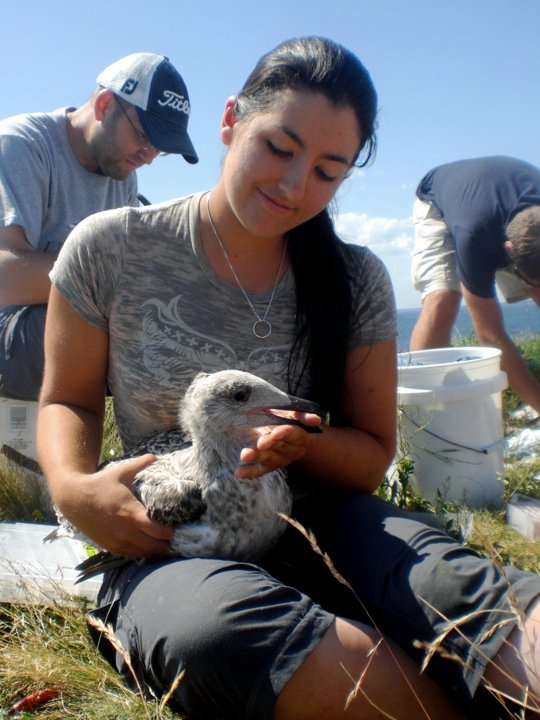 Photo ©
Shailee Shah
Photo ©
Shailee Shah
By Robyn Bailey, NestWatch Project Leader
Every summer from 2010-2016, intrepid students from Cornell University trekked to Shoals Marine Lab on Appledore Island off the coast of Maine in search of summer research experiences. For many of them, it was their first time conducting field research, and a lucky few would even go on to publish scientific papers on their project findings. But in order to do so, they had to brave one of New England’s most chaotic environments. I’m talking about the raucous, screaming, dive-bombing, poop-slinging clamor of a breeding gull colony.

Gull On Guard
A Great Black-backed Gull keeps an eye out for predators, including other gulls.
Over the course of these seven years, students clad in bicycle helmets (to ward off diving adults) monitored 1,564 nests of Great Black-backed Gulls and Herring Gulls. Under the supervision of faculty advisor Dr. David Bonter, they explored questions concerning parental defense of chicks, alarm-calling behavior, chick growth and survival, and the effects of pressures like storms and invasive European fire ants. Now a co-director of the Cornell Lab of Ornithology’s center for Engagement in Science and Nature, Dr. Bonter oversees numerous programs at the Lab including NestWatch. It was only fitting that the hard work that he and his students invested over the years should be formally archived in our NestWatch database.

Cute and Camouflaged
A Great Black-backed Gull chick is colored to match the rocky ground on which its parents typically nest.
This month, we bulk-uploaded 1,564 nest records which included 49,284 detailed nest checks. These data are now available to researchers around the world who may be interested in studying gull survival or other facets of colony-nesting seabird ecology. NestWatch would like to thank researchers collaborating on the project, including Dr. Julie Ellis, Dr. Sarah Courchesne, and Bill Clark, as well as the many students who helped collect the data: Sarah MacLean weighs and measures a gull chick that is near fledging age.

Measuring Chick Growth
- Natasha Bartolotta
- Facundo Fernandez-Duque
- Taylor Heaton Crisologo (read Taylor’s 2014 article here)
- Sarah MacLean
- Michelle Moglia
- Matthew Savoca
- Shailee Shah
- Ben Shattuck
- Justin Stilwell
- Christine Wilkinson
Mine! Mine!
Just as analysts can determine the survival rates of birds, they can also determine the survival rates of valuable data sets like the one provided by Dr. Bonter. A team of researchers recently discovered that the odds of a data set “surviving” decrease by 17% per year, unless properly archived in a long-lived database (Vines et al. 2014). This means that a data set can go extinct in about 26 years (<1% chance of it still existing). Many factors contribute to the loss of data over time. Technologies become obsolete (remember floppy disks?), people retire and throw away their boxes of old data, and notebooks kept by hobbyists are tossed out by loved ones who didn’t understand their value. With technology changing so rapidly, it is more important than ever for graduate students, researchers, bird clubs, and hobbyists to give their data a permanent home in a database that has a dedicated curator (like me) safeguarding it. As Dr. Bonter puts it, “We (researchers) owe it to society to make sure that our data sets don’t die with us. Tax dollars, donations, and volunteer labor are wasted if good data are not preserved in perpetuity.”
Most of us would agree that losing our work computer (without a backup) would be a major setback in productivity. Imagine losing 10, 20, or even 30 years’ worth of data! If you are sitting on a big pile of nesting data, please contact me about bulk uploading your data set to NestWatch. Like a gull after a french fry, I will take that off your plate.
Reference:
- Vines, T. H., A. Y. K. Albert, R. L. Andrew, F. Débarre, D. G. Bock, M. T. Franklin, K. J. Gilbert, J. Moore, S. Renaut, and D. J. Rennison. 2014. The availability of research data declines rapidly with article age. Current Biology 24(1):94-97. DOI: 10.1016/j.cub.2013.11.014
I’m so happy to see that gulls are getting attention, too! I am so very fond of them (fry bandits though they be)!
Gulls are not a menace to fries in South Florida in comparison to sandhill cranes. One pair used to stake out the drive-through of a fast-food restaurant. As your fries were handed to you, a red-crested head on a long neck would stick in through your open window and grab a fry (or three) My bird book said they were shy around humans; it hadn’t met these! And be careful what you snack on between holes. Sandhills particularly favor golf courses and golf carts are at just the right height to be “feeders”